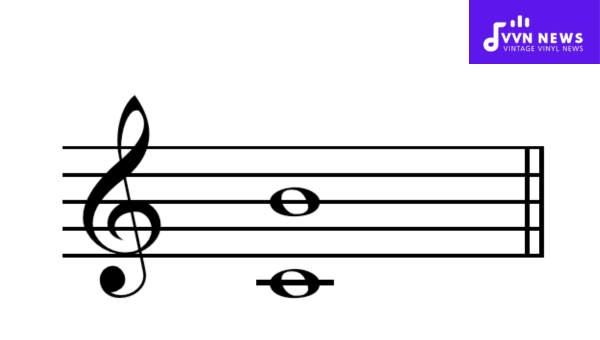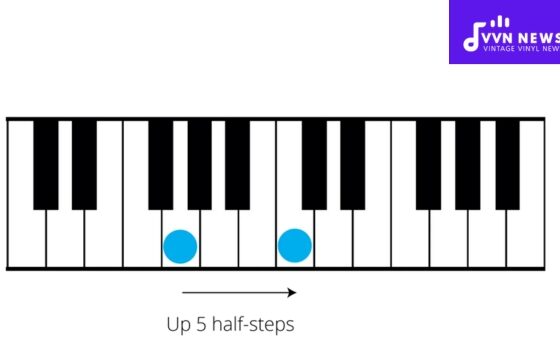From the spine-tingling highs to the soul-stirring lows, every note and sound come together to express emotions that sometimes words cannot. One of these key musical elements we hear so often but might not be quite familiar with is the major 7th intervals.
It’s a distinctive sound, a unique combination of notes that gives your music a specific color and flavor, making it resonate with listeners on a profound level.
If you’re intrigued by how these intervals can transform your music from ho-hum to extraordinary, or you’re just starting to learn the building blocks of harmony, then this post is for you.
Dive in as we explore the mystical world of major 7th intervals, including what they are, how to recognize them by ear and on sheet music, and how you can leverage these often underused yet powerful musical tools.
How is a Major 7th Interval Described?
A Major 7th interval is the penultimate step before you reach the octave in a major scale. It’s defined by the distance between the first note (the root) and the seventh note.
Sonically, it consists of 11 half-steps or semitones – producing a sound that’s almost complete but tantalizingly shy of resolution.
It imparts a sense of expectancy, urging progression towards the final eighth note, which brings consonance.
When played in sequence, these two pitches form a linear duo that’s highly distinctive – think take-off and landing, where the Major 7th takes flight, preparing for the stable grounding of the octave close behind.
Also Read: A Minor Scale [Unlock The Mysteries Of Musical Composition]
What are typical examples of Major 7th intervals?
When exploring major 7th intervals, it’s helpful to have a practical reference of these intervals in both ascending and descending orders:

Ascending Major 7th Intervals:
- From C to B
- From D to C#
- From E to D#
- From F to E
- From G to F#
- From A to G#
- From B to A#
Descending Major 7th Intervals:
- The reverse of the ascending order: B – C, C# – D, D# – E, E – F, F# – G, G# – A, and A# – B.
The characteristic stretch of major 7th intervals spans quite a distance—13 half steps when ascending and 11 half steps in its inversion.
Take the iconic opening of “Somewhere” from West Side Story or the final cadence in the verse of “Just The Way You Are” by Billy Joel; these melodies hinge on that poignant tension of major 7ths.
Translating these intervals into action on an instrument like a piano or guitar can unlock myriad expressive possibilities.
Also Read: F Sharp Minor Pentatonic Scale [How To Use In Your Compositions]
What distinct qualities do Major 7th intervals have?
The major 7th interval carries a distinctive sound that often evokes deep, complex emotions.
What sets it apart from other intervals is its less conventional but utterly compelling pull that can both intrigue and perplex the listener.
Harmonic Tension
A major 7th creates a tense, dissonant sound. When you strike two notes a major 7th apart, you’ll notice it doesn’t settle as comfortably as say, a perfect fifth or an octave. There’s an inherent drive to resolve to the octave, which gives it a sense of longing.
Resolution and Release
Linked with the tension is the art of resolution that major 7ths master so well.
They always seem to be reaching towards the next note up —the octave— representing completeness.
This interval acts like a musical cliffhanger, keeping your ears on edge until they hear that concluding note.
Sonic Character
In terms of tonal character, the major 7th has an ethereal quality to it. This interval tends to feel dreamy and introspective due to its placement near the end of the diatonic scale, right before everything resets at the octave.
Emotional Landscape
The emotional landscape painted by a major 7th is vast; just as it can instill unease due to its dissonance.
It also has an incredible capacity for conveying hopefulness and an introspective sort of joy how close it lingers beside resolution—the coveted home base that is the octave.
Incorporating this dramatic interval into music guarantees to enrich harmonic textures with exquisite tension and heartfelt storytelling through pitch relationships alone.
What methods work for identifying Major 7th intervals by ear?
Learning to recognize major 7th intervals by ear involves a few strategic steps that once mastered, will become second nature.

Familiarize yourself with the Sound
Start by immersing yourself in the distinctive sound of the major 7th interval.
It’s a sound that’s often perceived as bittersweet or yearning, similar to the final resolve of a story waiting to be concluded.
You might associate it with that last step before reaching the octave, which carries a tension almost begging for resolution.
Use Reference Songs
Reference songs can be powerful tools when learning intervals. A classic example of the major 7th is the introductory phrase from “Somewhere Over the Rainbow” – where “Some-” and “-where” span a major 7th.
Embedding this melody in your memory provides you with an instant recall mechanism for identifying this sound.
Interval Repetition Practice
Consistent practice is key. Create exercises where you play or sing various major 7th intervals in differing keys.
This repeated exposure will train your ears and help establish strong auditory recognition.
Contextual Listening
Listen to chord progressions and melodies within songs, especially those in jazz and classical music, where this interval is commonly utilized.
Pay sharp attention to moments where you feel a sense of anticipation or tension; often, these emotions are evoked by a major 7th.
Piano Keyboard Mapping
For visual learners, mapping out intervals on a piano keyboard can be beneficial. Recognize that a major 7th spans eleven half-steps—one semitone short of an octave.
By embracing these methods with dedicated practice sessions, soon picking out those poignant major 7ths will be something you’ll do effortlessly during your musical endeavors.
Also Read: How To Transpose Bass Clef To Treble Clef [A How-To Guide]
Executing Major 7th Intervals on Piano
To execute a major 7th interval on the piano, you need to combine two notes: the root note and a note that is 11 half-steps higher.
Here is the step-by-step process:
Step-by-Step Guide:
- Locate the Root Note: Start by identifying any note on the keyboard as your root. This will be your starting point.
- Counting Half Steps: From the root, count up 11 half-steps (or semitones). On a piano, this means you will move key by key, including both the white and black keys.
- Play Together: Press both keys simultaneously to hear how the major 7th interval sounds.
Example: If your root note is C (a white key), you would count up each key: C# (black), D (white), D# (black), E (white), F (white), F# (black), G (white), G# (black), A (white), A# (black) and finally arrive at B (white).
By integrating major 7th intervals into your music with these steps, their unique character will enhance your compositions or improvisations with rich harmonic texture.
Major 7th Intervals in the Whole Tone Scale
In the realm of harmony, the whole tone scale is a collection of notes that are all a whole step apart.

It exudes a dreamy and somewhat ambiguous character due to its symmetrical structure.
Major 7th intervals, don’t fit neatly within this scale because they are inherently asymmetrical; they consist of one semitone less than an octave.
Thus, if you start on any note within a whole tone scale and attempt to form a major 7th interval, you would ‘fall short’ since the subsequent note needed isn’t part of the scale’s limited palette.
Instead, these intervals are typically found in more traditional scales such as the major or harmonic minor.
Also Read: How To Transpose Treble To Bass Clef [Music Guide]
FAQs
What is a major 7th interval on the piano?
On the piano, a major 7th interval spans 11 half steps, or semitones, from the root note. For example, C to B is a major 7th.
Can you give an example of a song with a major 7th?
Yes! The opening notes of the song “Take on Me” by A-ha utilize a major 7th interval from F to E.
Is it difficult to sing a major 7th interval?
Singing a major 7th can be challenging due to its wide gap, but with practice, it becomes manageable.
How does the major 7th sound compare to other intervals?
The major 7th sounds are dissonant or tense, particularly when played in isolation and not within a chordal structure.
Why use major 7ths in composition?
Major 7ths add emotional depth and complexity, often evoking feelings of longing or thoughtful reflection in your compositions.
Conclusion
Major 7th intervals are the penultimate step of the diatonic scale, offering a bold, dissonant leap that often resolves beautifully into an octave. Recognizing these intervals by ear enhances your musical appreciation and enriches your playing or composition skills.
Embrace their distinct sound—practice identifying them on sheet music or your instrument of choice, and incorporate them into your musical creations.
These intervals can layer rich emotion and tension in your soundscapes that captivate listeners and leave a lasting impression.








